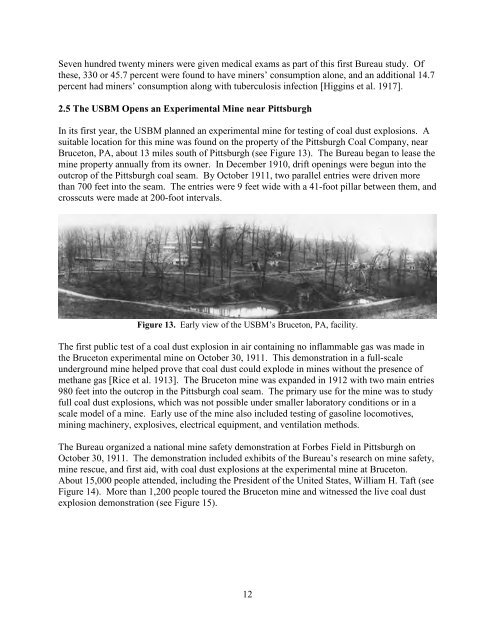One Hundred Years of Federal Mining Safety and Health Research
One Hundred Years of Federal Mining Safety and Health Research
One Hundred Years of Federal Mining Safety and Health Research
- No tags were found...
Create successful ePaper yourself
Turn your PDF publications into a flip-book with our unique Google optimized e-Paper software.
Seven hundred twenty miners were given medical exams as part <strong>of</strong> this first Bureau study. Of<br />
these, 330 or 45.7 percent were found to have miners’ consumption alone, <strong>and</strong> an additional 14.7<br />
percent had miners’ consumption along with tuberculosis infection [Higgins et al. 1917].<br />
2.5 The USBM Opens an Experimental Mine near Pittsburgh<br />
In its first year, the USBM planned an experimental mine for testing <strong>of</strong> coal dust explosions. A<br />
suitable location for this mine was found on the property <strong>of</strong> the Pittsburgh Coal Company, near<br />
Bruceton, PA, about 13 miles south <strong>of</strong> Pittsburgh (see Figure 13). The Bureau began to lease the<br />
mine property annually from its owner. In December 1910, drift openings were begun into the<br />
outcrop <strong>of</strong> the Pittsburgh coal seam. By October 1911, two parallel entries were driven more<br />
than 700 feet into the seam. The entries were 9 feet wide with a 41-foot pillar between them, <strong>and</strong><br />
crosscuts were made at 200-foot intervals.<br />
Figure 13. Early view <strong>of</strong> the USBM’s Bruceton, PA, facility.<br />
The first public test <strong>of</strong> a coal dust explosion in air containing no inflammable gas was made in<br />
the Bruceton experimental mine on October 30, 1911. This demonstration in a full-scale<br />
underground mine helped prove that coal dust could explode in mines without the presence <strong>of</strong><br />
methane gas [Rice et al. 1913]. The Bruceton mine was exp<strong>and</strong>ed in 1912 with two main entries<br />
980 feet into the outcrop in the Pittsburgh coal seam. The primary use for the mine was to study<br />
full coal dust explosions, which was not possible under smaller laboratory conditions or in a<br />
scale model <strong>of</strong> a mine. Early use <strong>of</strong> the mine also included testing <strong>of</strong> gasoline locomotives,<br />
mining machinery, explosives, electrical equipment, <strong>and</strong> ventilation methods.<br />
The Bureau organized a national mine safety demonstration at Forbes Field in Pittsburgh on<br />
October 30, 1911. The demonstration included exhibits <strong>of</strong> the Bureau’s research on mine safety,<br />
mine rescue, <strong>and</strong> first aid, with coal dust explosions at the experimental mine at Bruceton.<br />
About 15,000 people attended, including the President <strong>of</strong> the United States, William H. Taft (see<br />
Figure 14). More than 1,200 people toured the Bruceton mine <strong>and</strong> witnessed the live coal dust<br />
explosion demonstration (see Figure 15).<br />
12
















